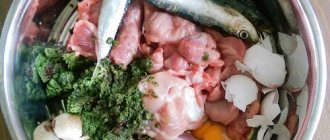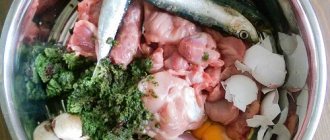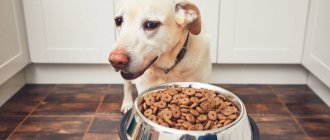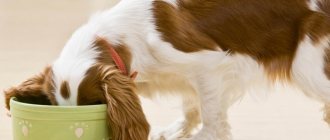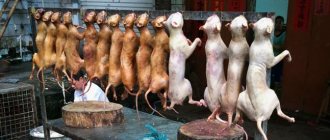Should meat be included in a dog's daily diet and in what quantities? What kind of meat products are recommended to be given to four-legged friends and how often should this be done? People who are getting pets for the first time are often looking for answers to these questions.
Dogs do have a biological need for meat. However, experts recommend paying enough attention to the choice of meat varieties, since much depends on the individual characteristics of a particular breed.
Basic Rules
Natural food for dogs is food that excludes dry food. This applies to:
- meat and offal;
- fish;
- dairy products;
- cereals and bran;
- vegetables and fruits.
There is a lot of controversy surrounding the principles of pet nutrition. Some veterinarians are in favor of ready-made food, while others are categorically against it. It’s up to you to decide how to feed your dog, but you need to remember that natural nutrition requires a lot of effort from the owner. After all, for it to be beneficial, the diet must be varied and balanced. Here are some basic rules:
- All components of a multi-component dish are mixed into bowls immediately before serving.
- Any food is given before feeding; if the dog leaves something, then the portion should be reduced.
- The pet must have constant access to clean and fresh water.
- Meat products are offered raw; it is advisable to freeze them beforehand, this will reduce the risk of infection by parasites.
- Meat, fish, dairy dishes do not mix.
- Food is cut into pieces according to the size of the individual; small breeds cannot “handle” large pieces.
- The diet includes cereals (buckwheat, rice, millet, rolled oats), pasta leads to excess weight.
- You can cook cereals in water or broth.
- If you mix meat with vegetables, both products must be in the same form (either raw or cooked), otherwise the rate of digestion will be different.
- Sea fish is served fresh; river fish are best boiled, as there is a high risk of infection with worms.
- The dishes are not seasoned (with the exception of a small amount of salt if the pet refuses bland food).
- Food must be fresh.
- It is prohibited to mix dry food with natural food for dogs; this causes serious disturbances in the gastrointestinal tract and metabolism.
If you decide to switch your pet from dry food to natural food, do it gradually. The optimal transition time is 14 days. During this period, it is better to give the animal probiotics, they will help normalize intestinal function.
Vitamins are also important for dogs with a natural diet. Even in a balanced diet, the owner cannot calculate the amount of useful elements eaten; as a rule, they are not enough, so multivitamin complexes are recommended.
Rules for soaking dry food
If for some reason the amount of dry food is soaked, it is recommended to adhere to the following rules:
- use clean drinking water (can be bottled or filtered), but not boiled. Temperature - 40°C;
- The ratio of liquid to dry product depends on the preferences and age of the dog, and the manufacturer’s recommendations. Possible ratios (water:feed) - 1:2, 1:3;
- In addition to water, you can use low-fat fermented milk products - yogurt or kefir. The diluent should not be sweet, the temperature should be room temperature;
- the daily feed intake is not increased or decreased. Only the consistency of the portion changes.
Important: soaked dry food should be eaten within 2-3 hours. At any temperature, such food quickly sours and is inseminated by bacterial flora. If fermented milk products are used, it is necessary to carefully monitor the animal's stool. Minor liquefaction that resolves quickly should not cause alarm. If diarrhea continues for a long time, it is necessary to stop soaking dry food and consult a veterinarian.
The manufacturer may set a limit on the soaking of dry granules, which should be noted on the food packaging.
Photo: pixabay.com
Advantages and disadvantages of natural food for dogs
Feeding with natural products has its pros and cons; after weighing them, you will understand how acceptable this method is for you. Benefits include:
- Control of the composition and quality of products, you choose them yourself.
- In the wild, ready-made food is not used, that is, this is the most natural type of nutrition.
- Homemade food does not contain preservatives, flavors and other flavoring additives that are used to increase the shelf life of “drying”.
- Compared to professional food, homemade meals are cheaper (especially for large breed dogs).
- You can vary the menu depending on the needs of your pet (it is easier to choose a diet for allergy sufferers, gastritis and kidney diseases).
Despite so many advantages, there are several major disadvantages:
- Labor intensity. The owner will have to prepare food once every 1-2 days.
- Difficulty maintaining balance. Calculating how many vegetables there should be, how many cereals, how many times a week there should be fish days is not so easy.
- Inconvenience of feeding while traveling or in the absence of owners. More often in this case, the animal is forced to switch to dry food, which causes the stomach to suffer even more.
- For small breed dogs, it is cheaper to use ready-made food, since they eat little, but have quite whimsical tastes.
Why do you need meat?
Despite the millennia-long history of living side by side with humans, we must not forget that our four-legged pets are still predators, which means protein is the main source of energy and nutrients for them.
The structure of the entire canine body is adapted to eating and digesting raw meat food, and this is what is most beneficial for them:
- Pronounced powerful fangs and sharp molars are present in the mouth of even a small indoor Italian greyhound, let alone the same shepherd dogs. This structure is specifically designed to chew and tear the muscles and veins of prey.
- A large amount of viscous saliva and the increased acidity of the large stomach make it possible to digest fairly large pieces of raw flesh without the danger of getting sick, because the caustic gastric juice calmly copes with any bacteria found in the eaten pieces.
- A short intestine is also indicative, because if the basis of the diet were herbs or cereals, then the beneficial substances simply would not have time to be absorbed into the walls and would not enter the blood. The complete digestive cycle of a healthy animal, regardless of its size, takes about a day.
Most wild and domestic representatives of the canine species do not disdain other types of food, chewing vegetables or various grains, but these are only additional vitamins, and they receive the bulk of energy and necessary microelements and vitamins from the main type of food.
How to properly feed your dog natural food?
The feeding regimen depends on the age and weight of the dog. It is important not to overfeed the animal or give too large portions. For proper nutrition, it is recommended to follow the following scheme:
| Dog's age | Number of meals |
| 1-4 weeks | 6-8 |
| 2-3 months | 5-6 |
| From six months to a year | 3 |
| Adult dog | 2 |
Sometimes breeders practice one-time feeding; this is not the most optimal option, since the pet eats a large portion at a time. Due to the feeling of hunger, he eats quickly, chews food poorly, and indigestion occurs. You can calculate the rate of feeding your dog natural food based on its weight:
- up to six months it is 6% of the animal’s weight;
- for older pets – 3-4%.
The figure may fluctuate, because there are hyperactive breeds that may require more calories, and there are pets that like to lie down and eat smaller portions.
Percentages are presented per day, that is, if you come up with a figure of 500 grams, you divide it by the number of meals.
The menu for your pet is also compiled in accordance with its basic needs. There is no need to make frequent changes; it is better for the diet to consist of familiar foods. It must contain:
- Meat products – 50-70%.
- Cereals and cereals 15-40%.
- Vegetables 15-25%.
- Up to 1% fat.
Feeding sterilized dogs natural food makes adjustments. Due to the tendency to be overweight, it is necessary to reduce the amount of porridge and increase the percentage of fiber (vegetables, fruits) and protein (meat).
Fish days include 1-2 times a week, it is better to give fatty varieties, they are boiled and cleaned of bones and heads. This food is allowed from 5 months, it is a source of protein.
Fermented milk products are a useful addition; they are given to an adult dog. Milk is offered during puppyhood. Such food will create healthy intestinal microflora.
Let's talk separately about the bones. The dog needs them to clean and grind their teeth. Porous or spongy bones are perfect; it is forbidden to give tubular parts of the chicken skeleton, they can injure the animal.
What can you give?
We said that it must be present in a pet’s diet, however, it can be varied. The permitted components will only bring benefits and saturate the body with the necessary microelements. Helpful supplements include:
- Vegetables and greens. Give everything except legumes, potatoes and white cabbage, they cause bloating.
- Chicken (if there is no allergy) and quail eggs are given raw 1-2 times a week; they are usually added to the main dish.
- Bran, they contain many useful elements, are added to liquid foods, and can be mixed with fermented milk products.
- Unsweetened fruits, berries, dried fruits, crackers, biscuits - in the form of a delicacy.
- Olive, flax, pumpkin, sunflower oils, their quantity depends on the size of the dog, add from a few drops to 1 tbsp. l.
Sometimes you can pamper your animal with store-bought treats, hard cheese, sauerkraut or seaweed.
What should you not give?
There is also a list of foods that are not recommended to be given. They cause gastrointestinal upset:
- confectionery;
- pasta and bakery products (lead to excess weight, difficult to digest);
- onions and garlic have an aggressive effect on the stomach;
- grapes cause fermentation and bloating;
- fatty meats, pork;
- mushrooms are not digestible, there is a risk of poisoning;
- soybeans, corn and semolina are poorly digestible;
- any preserved, spicy and fried food is taboo;
- Tubular and small fish bones carry a greater risk of injury.
Features of feeding puppies natural food
Babies up to 2 months feed on mother's milk. The use of ready-made formulas is permissible only if breastfeeding is impossible. Mixtures can be purchased at pet stores and veterinary pharmacies. Please note that cow or goat milk can only be used as an emergency option for a couple of days - the milk of these animals is different from dog milk, so it lacks some of the vitamins necessary for the puppy's health.
The first complementary foods are given at 3 weeks. All food (cereals, meat, vegetables) must be ground into pulp. Fermented milk products are introduced after 1.5 months, giving them several times a day. Homemade cottage cheese made from milk and kefir is good for strengthening children's bones.
From 4 months, yoghurt, kefir and cottage cheese are fed no more than once a day. Also, from this age it is allowed to give fresh cabbage. Before this time, it must be boiled. Additionally, you can include sea fish in your diet.
For up to six months, be sure to grind the rolled oats before serving. After changing teeth, be careful when removing bones - sharp molars can crush them into small fragments.
Monitor your weight gain regularly. If the indicator is too high or low, reconsider your diet.
Sample menu
The most convenient way is to create a menu for the week in advance. This way you will have frozen raw materials in advance, from which it is convenient to cook. By the way, you can make natural food on a small budget. Here are some recipes:
- Take beef heart or other offal (kaltyk, trachea, lung). For 1 kg. the main ingredient is 100 grams. dry rice. Boil the broth, then drain half (it can be used later), and add cereal to the other half and cook it. Finely chop the meat, add grated carrots and zucchini, season with a spoon of vegetable oil. The number of servings depends on the size of the dog.
- Cook the broth on the beef bone, it should be rich. Add buckwheat to get the consistency of liquid porridge. Cut the trimmings there, add carrots and fresh herbs.
- Not all pets love vegetables, they are especially important for older dogs, so you can use a trick. Cut carrots, pumpkin or zucchini into small slices, wrap them in cottage cheese, and roll them into a ball. Bake this dessert for 15-20 minutes, your pet will be happy.
Change by-products and grains; variations will provide the maximum amount of substances your dog needs.
Video: feeding a dog natural food, approximate diet and feeding table
Water in the diet
Water is one of the most important components of a dog's healthy diet, especially if the pet eats dry food. The younger the puppy, the more water needs to be added to the food portion. This will soften the food and make sure your pet gets enough water. Gradually, the dog itself begins to regulate the proportion of dry matter and water in its diet. At the same time, regardless of the pet’s age, the owner is obliged to ensure the dog’s constant access to clean water.
Useful tips
We have given all the necessary information to create the right diet. In conclusion, here are some more useful tips:
- Take raw materials from trusted sellers; farms and meat depots are best suited.
- Always cook or freeze the product.
- Do not overfeed your pet.
- The rules for calculating portions apply to an adult healthy dog; for a working or pregnant dog, the amount of food is increased; for domestic and elderly dogs, it is reduced.
- Never leave food in a bowl; your pet should eat everything until the end.
Natural food is as close as possible to the natural living conditions of animals. If you are willing to put in the time and effort, you can create a balanced, healthy diet that will ensure your pet’s excellent health.
If the dog does not eat enough dry food
All these rather complex and sometimes inaccurate calculations are needed to ensure that the dog does not starve and receives the maximum amount of nutrients from the food it eats. Of course, if a dog is constantly begging for treats and food from the owner’s table, this does not mean that the portion of food is not enough for him. However, you should carefully ensure that the offered portion is enough. Symptoms of deficiency may include:
- after feeding, the dog does not leave the bowl, freezes, waiting for more;
- the dog’s ribs, pelvic bones and scapular edges are clearly visible;
- the hunger pit is pronounced;
- the fat layer is thin.
These signs indicate that the dog is underweight. This can be either a consequence of the disease or insufficient nutritional value of the daily diet. In this case, the owner must:
- Visit your veterinarian to rule out your pet losing weight as a result of illness. For example, infections with parasites;
- if the dog receives super premium or holistic food, it is worth increasing the portion. Perhaps the animal’s physical activity has increased, its physiological state has changed, the cold season has arrived - all these are reasons to increase the proportion of dry granules in the bowl;
- if feeding is carried out with a diet of a lower class, choose higher quality, high-calorie and energy-rich dry food. It is better to choose an option, buying it in small packages in order to choose exactly what your dog will like;
- You can switch your dog to a mixed diet according to the following scheme: wet canned food + dry granules. Canned food is more nutritious and is often more appealing to animals.
Raw or cooked
Although raw meat is a natural food for dogs, the answer to this question is controversial. Both raw and cooked foods have advantages and disadvantages. When making a decision, the owner must clearly understand the benefits and possible harms of the chosen feeding method.
Raw meat
| pros | Minuses |
| High nutritional value |
Rich in essential amino acids
Correct formation of the animal’s skeleton and muscle tissue
Prevention of anemia - increasing the level of hemoglobin in the blood
Improvement of the immune system and overall endurance of the body
Prevention of diseases of the animal’s teeth and jaws by chewing coarse meat fibers
Cooked meat
| Danger of infection with helminths and infectious diseases | |
| pros | Minuses |
| Safe against parasites and some infectious diseases |
The high concentration of hydrochloric acid in a dog's stomach allows it to disinfect stale food contaminated with pathogenic microorganisms. Despite this, you should only feed your dog raw meat if you have full confidence in its safety and high quality.
Only meat from farm animals that is purchased in a store can be considered uncontaminated. It is subject to mandatory sanitary and veterinary control.
Raw meat from wild animals, such as small rodents, is strictly not recommended for your dog. Hunting dog breeds are at risk when walking through the forest with their owner.
To protect raw meat of questionable quality, you can place it in the freezer for several days. Parasite eggs die from a sharp drop in temperature.
Important! When preparing a meat dish for a dog, you should not add salt or other spicy spices. If you are thinking about whether you can treat your pet to a tasty piece of smoked meat, it is better to refuse it. Food additives in such meat have a negative effect on the condition of the dog’s liver.
The broth left over after cooking meat should not be fed to the dog - it is too concentrated. You can use it to cook cereal porridge or vegetables.
What varieties are suitable?
The most classic and safe choice has always been beef. This is a balanced type that contains all the necessary elements and is not too fatty, easy to digest and does not contain possible dangerous infections and parasites, it is ideal for a dog living in the city.
Most pets enjoy eating lean beef throughout their lives. However, these are far from the only options. You can also feed your dog:
Pork is perhaps the only type of meat that dogs should not eat. It is too fatty and contains too few nutrients. A dog’s stomach simply cannot digest and assimilate it, so feeding this product is simply a waste of the owner’s money and harms the pet’s health.

